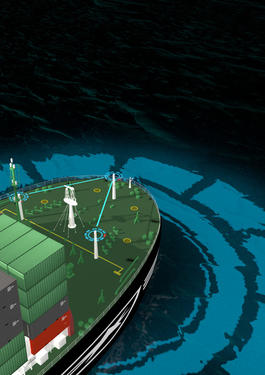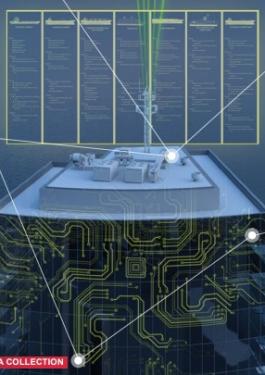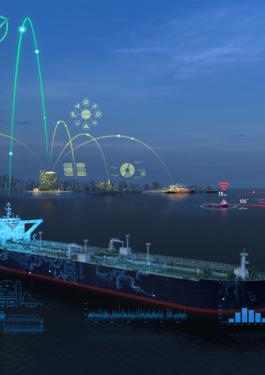Are we ready for autonomous ships?
Autonomous shipping gets a mixed press. While some sectors of the industry believe automated or autonomous technology will transform their business, many shipping companies are more reluctant to invest. Meanwhile, the regulatory landscape supporting its safe development is still in flux. Here is our look at where autonomous shipping stands today – and what will be needed to take the next steps.
Do autonomous ships already exist?
The answer is yes – and no. Some small unmanned military ships and survey vessels are already in use. But large merchant ships have yet to move beyond a basic level of autonomy, citing high costs and concerns about cyber and operational risk as obstacles to adoption. Moreover, autonomous does not necessarily imply unmanned.
Autonomous, automated or “just” smart?
- Smart: leverages well-defined data sets to improve efficiency through enhanced connectivity
- Automated: performs a specific task or function within a well-defined and restricted scope
- Autonomous: can self-sufficiently learn, adjust and evolve in response to dynamic environments
Does smarter mean safer?
Owners bullish on smart technology tend to cite its potential to improve efficiency. By investing in smart technology – and in the future, artificial intelligence to enable fully autonomous decision-making – owners can manage fuel consumption, reduce crew, and improve profitability.
But we would argue strongly that the number one benefit of increasing ship autonomy is safety. According to EMSA, in shipping, more than 80 percent of accidents on ships are caused by human error1. The use of sensors to collect data, and systems to process it and provide operational guidance reduces the likelihood of accidents, damage and polluting spills. Aside from that, unmanned operations reduce the risk of exposing crew to hazardous situations.
And there are other reasons why increasingly autonomous ships are good news for crew. It’s likely that small- to medium-sized vessels operating in national waters will be supervised by a person on shore. This means that far from being replaced, crews will find new roles emerging in remote operations centers. This may prove a welcome development for many, allowing them more time on shore and enjoying the comforts of home.
Where are we in autonomous shipping regulation?
Autonomous ships need to achieve a safety level equivalent to conventional ships. This is hard to define as much of what the industry defines as “safe” is built on historic knowledge and lessons learned from accidents.
At a basic level, autonomous ships must comply with relevant regulations (i.e. SOLAS, MARPOL, COLREG and STCW). Operational risks for autonomous ships are generally similar to conventional ships, but with risk transferred from crew to sensors and cyber-physical systems. Autonomous ships must be able to navigate without colliding with other vessels, taking into account traffic and unexpected situations. They must be able to maneuver and remain stable, and withstand unauthorized physical or virtual intrusion. It also has implications for cargo management in terms of cargo securing and monitoring. Reducing or removing crew also puts increased demands on system reliability and security.
However, when it comes to regulations specific to autonomous shipping, the framework is lagging behind the technology. This is largely an issue of complexity. First, there is the fact that the systems and equipment involved are new and are evolving quickly, which makes standardization a moving goalpost. Second, there is the widespread impact that ship autonomy will have on its operation, which implies that existing instruments and standards will need to be reviewed and updated. Third, there is the complicating factor of remote operations. This is a particular sticking point – a vessel and its remote operations center may not be under the same national regulations, and a single center may be operating several vessels in different national waters.
At IMO level, work is being done to develop the goal-based Maritime Autonomous Surface Ship (MASS) Code. The IMO aims to ensure that the MASS Code will keep pace with rapid technological developments. A MASS Code draft is expected to be completed in 2025, and to become mandatory by 2028.
Head of Digital & Autonomous Ship Rules
Bureau Veritas M&O
When we are talking about autonomous shipping, it is important to remember that “not now” does not mean “never.
For now, it is true that there are few autonomous ships out on our seas. Autonomous shipping offers safety benefits and operational efficiencies, so we can be sure that it will be more widespread one day. The critical work in the meantime is making the progress needed to ensure autonomous shipping can be adopted safely when the industry is ready.
Bureau Veritas guidelines for autonomous shipping
Bureau Veritas has developed a structured approach to risk and reliability for autonomous ships. Our Guidelines for Autonomous Shipping cover four main areas:
- The scope and definition of autonomy applicable
- A risk and technology assessment including identification and analysis of risks and how they could be mitigated
- The functionality of autonomous systems, defining minimum levels for essential systems and providing goal-based recommendations
- The reliability of autonomous systems, including recommendations on design and performance levels. A quality assurance methodology is also provided.
They are based on longstanding expertise built by Bureau Veritas in the marine sector, leverage our Rules and guidelines for identifying, analyzing and mitigating all types of risk, and refer to established international and national regulatory frameworks.
Since 2022, Bureau Veritas offers the design approval and survey scheme for unmanned autonomous vessels below 500 GRT through the class notation USV, as per the Rule Note NR681.
As a classification society, Bureau Veritas supports its customers in their autonomous shipping journey, while also helping to shape international regulatory frameworks. This latter role is crucial when it comes to tackling a potentially huge shift in the workings of a global industry. Bureau Veritas has been contributing to this work at IMO level, and through IACS and other bodies.
Collaboration across international and national bodies is essential to ensure autonomous shipping is supported by a standardized and workable regulatory landscape. With so many elements at play and legal, technical and ethical complexities to balance, the best way forward will be to work together.













